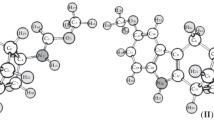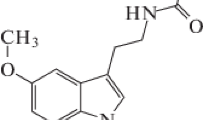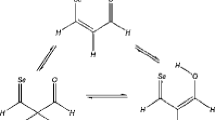Abstract
The microwave spectra of the normal and the 2-13C isotopic species of 1-cyanobicyclo[1.1.0]butane have been observed and assigned, leading to the following rotational constants: (normal), A=8807.202 ± 0.004, B=2924.334 ± 0.002, C=2509.322 ± 0.002 and (isotope), A=8608.85 ± 0.85, B=2902.88 ± 0.02, and C=2478.56 ± 0.02 MHz. Measurements of the second-order Stark effect led toμ T=4.08 ± 0.01 D. Based on the available microwave data coupled with geometryoptimizedab initio molecular orbital structures for cyanocyclopropane and 1-cyanobicyclo[1.1.0]-butane, a molecular structure for the latter molecule is proposed. Analysis of the dipole moments of these molecules and of bicyclo[1.1.0]butane has led to the conclusion that the bicyclobutyl group is a better electron donor than is cyclopropyl. In addition, a simple frontier molecular orbital model is not sufficient for explaining all of the structural changes that occur on substituting cyano at the bridgehead of bicyclo[1.1.0]butane.
Similar content being viewed by others
References
Harmony, M. D.; Nandi, R. N.; Tietz, J. V.; Choe, J.-I.; Getty, S. J.; Staley, S. W.J. Am, Chem. Soc.,1983,105, 3947.
Harmony, M. D.; Mathur, S. N.; Choe, J.-I.; Kattija-Ari, M.; Howard, A.E.; Staley, S.W.J. Am. Chem. Soc.,1981,103, 2961.
Hoffmann, R.Tetrahedron Lett.,1970, 2907.
Taylor W. H.; Harmony, M. D.; Cassada, D.A.; Staley, S.W.J. Chem. Phys.,1984,81, 5379.
Pomerantz M.; Abrahamson, E. W.J. Am. Chem. Soc.,1966,88, 3970.
Newton, M. D.Mod. Theor. Chem. (Appl. Electron. Struct. Theory),1977,4, 223.
Cox, K. W.; Harmony, M. D.; Nelson, G.; Wiberg, K. B.J. Chem. Phys.,1969,50, 1976.
Hall, H. K., Jr.; Blanchard, E. P., Jr.; Cherkofsky, S. C.; Sieja, J. B.; Sheppard, W. A.J. Am. Chem. Soc.,1971,93, 110.
Wodarczyk, F. J.; Wilson, E. B.J. Mol Spectrosc.,1971,37, 445.
Mathur S. N.; Harmony, M. D.J. Mol Spectrosc.,1978,69, 37.
Muenter, J. S.J. Chem. Phys.,1968,48, 4544.
Binkley, J. S.; Frisch, M.; Raghavachari, K.; DeFrees, D.; Schlegel, H. B.; Whiteside, R.; Fluder, F.; Seeger, R.; Pople, J. A. GAUSSIAN 82, Release H, Carnegie Mellon University, Pittsburgh, PA, 1982.
Binkley, J. S.; Pople, J. A.; Hehre, W. J.J. Am. Chem. Soc.,1980,102, 939.
Hariharan, P. C.; Pople, J. A.Chem. Phys. Lett.,1972,16, 217;Theor. Chim. Acta,1973,28, 213.
Binkley, J. S.; Pople, J. A.Int. J. Quantum Chem.,1975,9, 229.
Graner G.; Thomas, C.J. Chem. Phys.,1968,49, 4160.
Golden, S.; Wilson, E. B., Jr.J. Chem. Phys.,1948,16, 669.
Staley, S. W.; Norden, T. D.; Su, C.-F.; Rall, M.; Harmony, M. D.J. Am. Chem. Soc.,1987,109, 2880. The values ofμ(3–21G) andμ(6–31G*)for 4 are 4.231 and 4.418 D, respectively.
Chang, T.-A.; Harmony, M. D.; Staley, S. W.J. Mol. Struct.,1988,190, 17. The value of C1C4N given in this report is 360° minus the value of C1C4N given in ref. [18]. The CN bond is rotated away from H1.
Costain, C. C.J. Chem. Phys.,1958,29, 864.
These are drawn with the Psi 77 program at 3–21G*: W. L. Jorgensen, W. L.Quantum Chemistry Program Exchange,1977,11, 340.
Deakyne, C. A.; Allen, L. C.; Craig, N. C.J. Am. Chem. Soc.,1977,99, 3895.
Dakkouri, M.; Ruedel, K.; Typke, V.; Caminati, W.Acta Chem. Scand. A,1988,42, 519.
Callomon, J. H.; Hirota, E.; Kuchitsu, K.; Lafferty, W. J.; Maki, A. G.; Pote, C. S.Landolt-Börnstein, II(7); Hellwege, K.-H.; Hellwege, A. M. (Eds.),1976, 285.
Dakkouri, M.; Ephardt, H.; Siam, K.; Schäfer, L.; Van Alsenoy, C.J. Mol. Struct.,1987,159, 123.
Ghosh, S. N.; Trambarulo, R.; Gordy, W.J. Chem. Phys.,1953,21, 308.
Carvalho, R., Ph.D. thesis, Columbia University, New York, 1966;Diss. Abstr. B,1967,28, 620.
Fong, M. Y.; Harmony, M. D.J. Chem. Phys.,1973,58, 4260.
Harmony, M. D.; Cox, K. W.J. Am. Chem. Soc.,1966,88, 5049.
Hall, H. K., Jr.; Baldt, J. H.J. Am. Chem. Soc.,1971,93, 140.
Pomerantz, M.; Hillenbrand, D. F.Tetrahedron,1975,31, 217.
Author information
Authors and Affiliations
Rights and permissions
About this article
Cite this article
Taylor, W.H., Harmony, M.D. & Staley, S.W. Microwave spectrum, dipole moment, and a proposed structure for 1-cyanobicyclo[1.1.0]butane. Struct Chem 2, 167–173 (1991). https://doi.org/10.1007/BF00676628
Received:
Accepted:
Issue Date:
DOI: https://doi.org/10.1007/BF00676628




